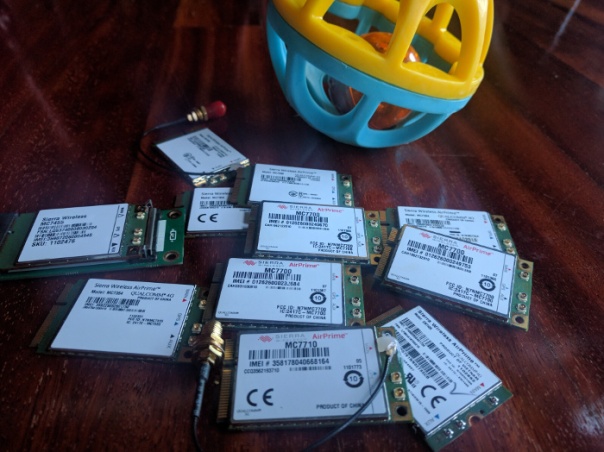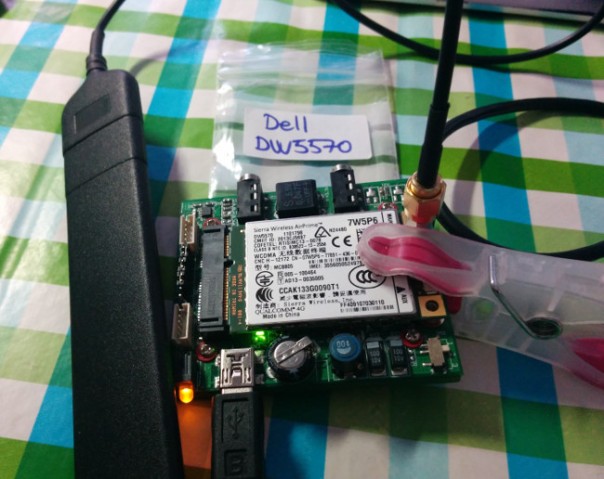Blog Archives
QMI firmware update with libqmi
 qmi-firmware-update
qmi-firmware-update
One of the key reasons to keep using the out-of-tree Sierra GobiNet drivers and GobiAPI was that upgrading firmware in the WWAN modules was supported out of the box, while we didn’t have any way to do so with qmi_wwan in the upstream kernel and libqmi.
I’m glad to say that this is no longer the case; as we already have a new working solution in the aleksander/qmi-firmware-update branch in the upstream libqmi git repository, which will be released in the next major libqmi release. Check it out!
The new tool is named, no surprise, qmi-firmware-update; and allows upgrading firmware for Qualcomm based Sierra Wireless devices (e.g. MC7700, MC7710, MC7304, MC7354, MC7330, MC7444…). I’ve personally not tested any other device or manufacturer yet, so won’t say we support others just yet.
This work wouldn’t have been possible without Bjørn Mork‘s swi-update program, which already contained most of the bits and pieces for the QDL download session management, we all owe him quite some virtual beers. And thanks also to Zodiac Inflight Innovations for sponsoring this work!
Sierra Wireless SWI9200 series (e.g. MC7700, MC7710…)
The upgrade process for Sierra Wireless SWI9200 devices (already flagged as EOL, but still used in thousands of places) is very straightforward:
- Device is rebooted in boot & hold mode (what we call QDL download mode) by running AT!BOOTHOLD in the primary AT port.
- A QDL download session is run to upload the firmware image, which is usually just one single file which contains the base system plus the carrier-specific settings.
- Once the QDL download session is finished, the device is rebooted in normal mode.
The new qmi-firmware-update tool supports all these steps just by running one single command as follows:
$ sudo qmi-firmware-update \
--update \
-d 1199:68a2 \
9999999_9999999_9200_03.05.14.00_00_generic_000.000_001_SPKG_MC.cwe
Sierra Wireless SWI9x15 series (e.g. MC7304, MC7354…)
The upgrade process for Sierra Wireless SWI9x15 devices is a bit more complex, as these devices support and require the QMI DMS Set/Get Firmware Preference commands to initiate the download. The steps would be:
- Decide which firmware version, config version and carrier strings to use. The firmware version is the version of the system itself, the config version is the version of the carrier-specific image, and the carrier string is the identifier of the network operator.
- Using QMI DMS Set Firmware Preference, the new desired firmware version, config version and carrier are specified. When the firmware and config version don’t match the ones currently running in the device, it will reboot itself in boot & hold mode and wait for the new downloads.
- A QDL download session is run to upload each firmware image available. For these kind of devices, two options are given to the users: a pair of .cwe and .nvu images containing the system and carrier images separately, or a consolidated .spk image with both. It’s advised to always use the consolidated .spk image to avoid mismatches between system and config.
- Once the QDL download sessions are finished, the device is rebooted in normal mode.
Again, the new qmi-firmware-update tool supports all these steps just by running one single command as follows:
$ sudo qmi-firmware-update \
--update \
-d 1199:68c0 \
9999999_9902574_SWI9X15C_05.05.66.00_00_GENNA-UMTS_005.028_000-field.spk
This previous commands will analyze each firmware image provided and will extract the firmware version, config version and carrier so that the user doesn’t need to explicitly provide them (although there are also options to do that if needed).
Sierra Wireless SWI9x30 series (e.g. MC7455, MC7430..)
The upgrade process for Sierra Wireless SWI9x30 devices is equivalent to the one used for SWI9x15. One of the main differences, though, is that SWI9x15 devices seem to only allow one pair of modem+pri images (system+config) installed in the system, while the SWI9x30 allows the user to download multiple images and then select them using the QMI DMS List/Select/Delete Stored Image commands.
The SWI9x30 modules may also run in MBIM mode instead of QMI. In this case, the firmware upgrade process is exactly the same as with the SWI9x15 series, but using QMI over MBIM. The qmi-firmware-update program supports this operation with the –device-open-mbim command line argument:
$ sudo qmi-firmware-update \
--update \
-d 1199:9071 \
--device-open-mbim \
SWI9X30C_02.20.03.00.cwe \
SWI9X30C_02.20.03.00_Generic_002.017_000.nvu
Notes on device selection
There are multiple ways to select which device is going to be upgraded:
- vid:pid: If there is a single device to upgrade in the system, it usually is easiest to use the -d option to select it by vid:pid (or even just by vid). This is the way used by default in all previous examples, and really the easiest one if you just have one modem available.
- bus:dev: If there are multiple devices to upgrade in the same system, a more restrictive device selection can be achieved with the -s option specifying the USB device bus number plus device number, which is unique per physical device.
- /dev/cdc-wdm: A firmware upgrade operation may also be started by using the –cdc-wdm option (shorter, -w) and specifying a /dev/cdc-wdm device exposed by the module.
- /dev/ttyUSB: If the device is already in boot & hold mode, a QDL download session may be performed directly on the tty specified by the –qdl-serial (shorter, -q) option.
Notes on firmware images
Sierra Wireless provides firmware images for all their SWI9200, SWI9x15 and SWI9x30 modules in their website. Sometimes they do specify “for Linux” (and you would get .cwe, .nvu or .spk images) and sometimes they just provide .exe Windows OS binaries. For the latter, you can just decompress the .exe file e.g. using 7-Zip and get the firmware images that you would use with qmi-firmware-update, e.g.:
$ 7z x SWI9200M_3.5-Release13-SWI9200X_03.05.29.03.exe
$ ls *.{cwe,nvu,spk} 2>/dev/null
9999999_9999999_9200_03.05.29.03_00_generic_000.000_001_SPKG_MC.cwe
[TL;DR?]
qmi-firmware-update now allows upgrading firmware in Sierra Wireless modems using qmi_wwan and libqmi.
Dell-branded Sierra Wireless 3G/4G modem not online?

Your Dell modem not getting online?
It’s not uncommon to find weird mobile broadband modems that for one reason or another don’t end up working as expected with NetworkManager/ModemManager; but the new 3G/4G modems in Dell laptops are at a total different level. These Dell-branded devices are really Sierra Wireless powered modems, e.g. the Dell 5808 is a Sierra Wireless MC7355, or the Dell DW5570 is a Sierra Wireless MC8805.
[UPDATE]
Looks like not only Dell-branded modems are affected by this issue. According to some user reports HP-branded modems like the HP lt4111 (based on the Sierra Wireless EM7355) are also affected by the issue.
Late last year we started to receive several bugreports in the ModemManager and libqmi mailing lists for these kind of devices. Basically, the modem would never get to a proper online mode with the RF transceivers powered and therefore would never even get registered in the mobile network. This was happening to both QMI and MBIM based configurations, and the direct error message reported by libqmi when trying to get into online mode was just… not very very helpful.
$ sudo qmicli -d /dev/cdc-wdm1 --dms-get-operating-mode
[/dev/cdc-wdm1] Operating mode retrieved:
Mode: 'low-power'
HW restricted: 'no'
$ sudo qmicli -d /dev/cdc-wdm1 --dms-set-operating-mode=online
error: couldn't set operating mode: QMI protocol error (3): 'Internal'
The issue was reported to the kernel, assuming that this would likely be a new missing rfkill related setup in newer Dell laptops. One of the users reported in that same bugreport that actually using Sierra’s GobiNet driver instead of qmi_wwan would end up putting the modem in online mode, so just switching drivers during boot would make it work. WTF?
Digging in Sierra’s GobiNet QMI driver
Well, without much hope of finding anything, and given that I had just bought such a Dell modem myself for testing a new “Dell” plugin, I decided to dig into Sierra’s kernel driver sources. Apart from some already known things (e.g. they use the WDA service to set the net data format in new modems instead of the old CTL service), these lines popped:
if (is9x15)
{
// Set FCC Authentication
result = QMIDMSSWISetFCCAuth( pDev );
if (result != 0)
{
return result;
}
}
The Sierra GobiNet driver is sending some magic “FCC auth” command during boot to the modem; which according to the driver sources maps to command 0x555F in the DMS service. Hey I should try that!
Adding the new command support in libqmi wasn’t difficult, so in some minutes I was ready to test it… and worked.
$ sudo qmicli -d /dev/cdc-wdm1 --dms-get-operating-mode
[/dev/cdc-wdm1] Operating mode retrieved:
Mode: 'low-power'
HW restricted: 'no'
$ sudo qmicli -d /dev/cdc-wdm1 --dms-set-fcc-authentication
[/dev/cdc-wdm1] Successfully set FCC authentication
$ sudo qmicli -d /dev/cdc-wdm1 --dms-get-operating-mode
[/dev/cdc-wdm1] Operating mode retrieved:
Mode: 'online'
HW restricted: 'no'
Support for this is already available automatically when using libqmi and ModemManager git master. It will hit the next stable releases likely as well.
[UPDATE]
These fixes have been already released in ModemManager 1.4.4 and libqmi 1.12.4.
MBIM?
Well, I don’t know if there is any command in MBIM to do the same operation (likely there is in a Sierra-specific service), but one thing we could anyway try to do is to use “QMI embedded in MBIM“, which Bjørn has already tested some times. I’ll try to test that some day, but I’ll need to get another modem as my DW5570 only comes up with a QMI configuration. For now, if you’re stuck with this problem using MBIM, you can likely just select USB configuration #1 using usb_modeswitch and get the modem switched to QMI mode.
[UPDATE]
If your modem is being managed in MBIM and not in QMI, you can now use Collin McMillan’s tool to issue the QMI FCC Auth command embedded in MBIM transactions.
TL;DR?
Dell-branded Sierra Wireless modems need the “FCC Auth” command (QMI DMS service, 0x555F) before they can be brought online; supported in libqmi and ModemManager already.
ModemManager is fun
These last weeks I’ve been out of my usual Tracker work, and have been hacking on NetworkManager/ModemManager so that they can work properly with Sierra Wireless Airlink Fastrack Xtend modems.
Ended up writing a new wavecom plugin for this purpose (Wavecom was bought by Sierra Wireless in 2009), which Dan already merged in the master branch of ModemManager.
The changes in the new wavecom plugin with respect to the generic GSM plugin are:
- AT+CPIN? replies are not ended with OK. A custom regex match was added to support CPIN? replies without OK (also had to hack the generic MM code to handle plugin-provided regular expressions).
- Disabled default power-up comand, AT+CFUN=1. This command does a full software reset in the device, including the USB stack, so the connection is closed. No additional command seems to be needed, as the modem wakes up by default in CFUN=1 (full functionality) mode. Anyway, an additional check was added during initialization so that this mode is ensured.
- Enabled RTS/CTS instead of XOFF/XON flow control.
- Implemented access technology retrieval using AT+WGPRS=9,2 to query network capabilities
- Ensure the modem uses the highest possible mobile class. These modems can be configured to use different mobile classes. For each kind of modem, the best mobile class is the highest one available, in the following order:
- Class A (3G only mode)
- Class B (PS or CS, GPRS/EDGE or GSM)
- Class CG (PS only, GPRS/EDGE)
- Class CC (CS only, GSM)
- Implemented setting and getting allowed mode, for both 2G and 3G based modems (using AT+WWSM command in the 3G case).
- Implemented setting and getting frequency bands for 2G modems (with AT+WMBS) and 3G modems (with AT+WUBS).
Still, the plugin could be improved even more. For example, there is no secondary port handling in the current plugin implementation, which means that signal strength value will not be updated while the modem is in connected state. This kind of modems support setting up virtual ports by multiplexing the serial channel (CMUX), but ModemManager doesn’t handle this yet.
If anyone has one of this Wavecom/SierraWireless modems at home, please test it with latest ModemManager and report any errors found.
